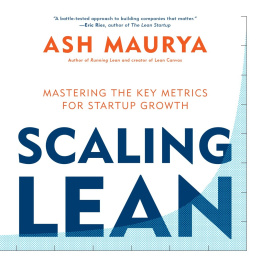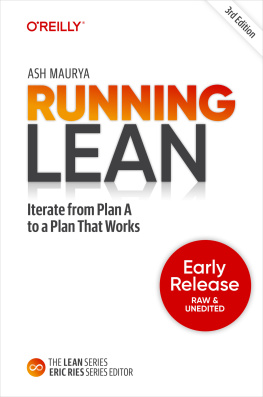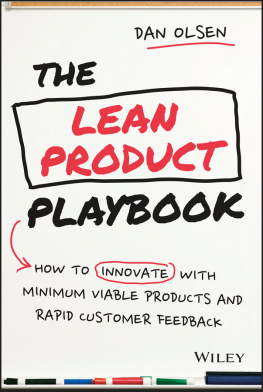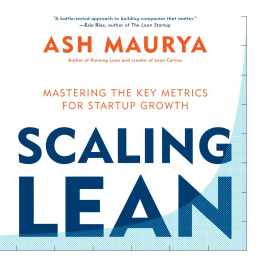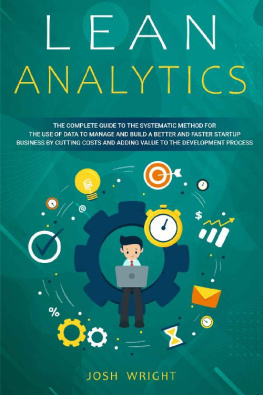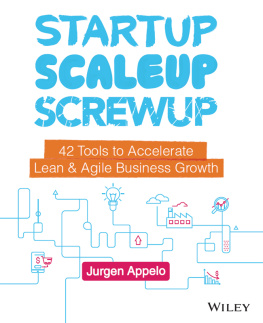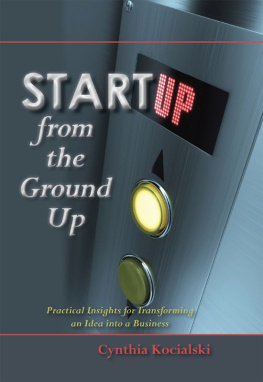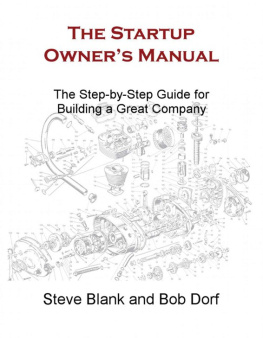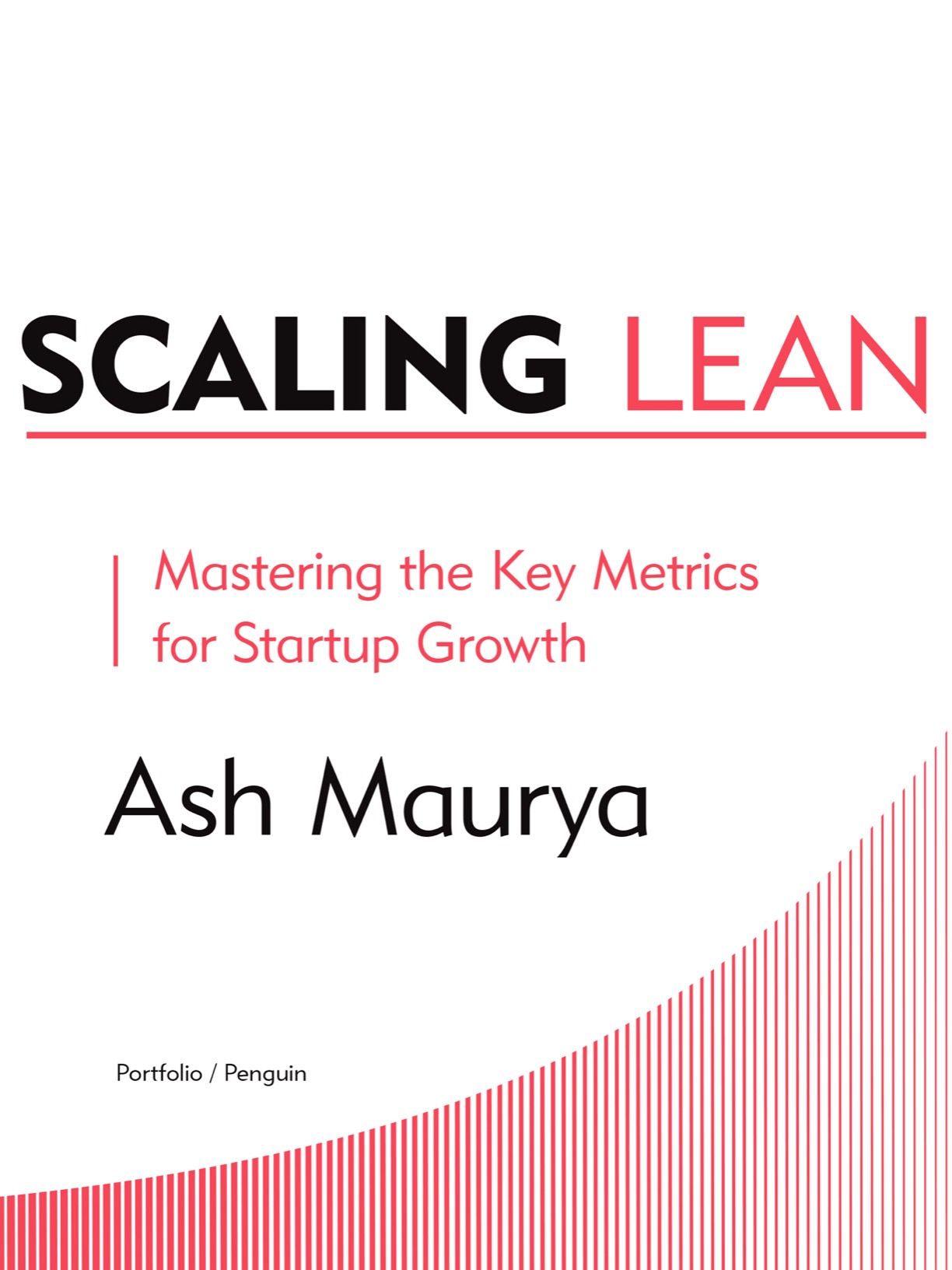Penguin supports copyright. Copyright fuels creativity, encourages diverse voices, promotes free speech, and creates a vibrant culture. Thank you for buying an authorized edition of this book and for complying with copyright laws by not reproducing, scanning, or distributing any part of it in any form without permission. You are supporting writers and allowing Penguin to continue to publish books for every reader.
While the author has made every effort to provide accurate telephone numbers, Internet addresses, and other contact information at the time of publication, neither the publisher nor the author assumes any responsibility for errors or for changes that occur after publication. Further, the publisher does not have any control over and does not assume any responsibility for author or third-party Web sites or their content.
To Sashafor constantly helping me see the larger goal.
INTRODUCTION
Another Book About Startup Growth?
A nother book about startup growth metrics? Why add to an already crowded shelf?
I have had the entrepreneurial bug my whole life. I came to the United States on a student visa which restricted me from starting a company. So I did the next best thing. I joined a telecom startup shortly after graduating from university. After a few false product starts, that startup eventually found product/market fit with a voice-over-IP softswitch product, which led to a successful exit in 2002. That is when I left to launch my first startup, WiredReach. Like the earlier startup, WiredReach began with a few false starts until I found product/market fit with a file-sharing product targeted at small businesses. I subsequently sold that business in 2010 to start my latest venture, LeanStack. Our mission is helping entrepreneurs everywhere succeed.
My first book, Running Lean, grew out of the first set of challenges I experienced as a startup founder: the need to quickly iterate from an early-stage idea (or plan A) into a plan that works. I had built many products over the years, and while they all started out equally exciting, not all of them stood the test of the market. I realized that I had many more ideas than I had time or resources to test them. More important, I didnt have a repeatable process for doing so.
Lifes too short to build something nobody wants.
This prompted my search for the repeatable metaprocess I describe in Running Lean. It was derived from rigorous testing and firsthand experiential learning by building many of my own products and by working alongside hundreds of other entrepreneurs spread across the globe in domains ranging from software to hardware and high-tech to no-tech businesses.
The big epiphany for me while writing and researching Running Lean was that the true product of a successful entrepreneur is not just a great solution or an innovative piece of technology, but a repeatable process that connects your solution with paying customersin other words, finding a working business model.
But it turns out thats not enough. Running Lean, though it delivered on its promise, described only the first step in a two-step process on the path to building a successful startup. Over time I found that when the time came to scale up my products and teams, my most rigorously tested business models faced a whole new set of challenges. I learned firsthand that seemingly watertight business models can disintegrate under the pressures of expanding into new markets and managing stakeholder expectations.
I went searching for a solution.
Scale Starts with Metrics
Building a scalable and successful business starts with knowing what to measure and how.
The first and most important stakeholder in the business is you, and your scarcest resource is time. Every minute spent on a business that is doomed to fail is a waste, and so its critical for you to be able to identifyquickly, early, and accuratelywhether a business idea is worth pursuing.
You are the first investor in your business idea. You invest with time, which is more valuable than money.
Whats more, youre going to be called on to demonstrate progress to external shareholders. From the earliest days of a startups life, you as a founder have to justify your new ventures potential for progress to a VC, CFO, spouse, or even yourself as a prerequisite to securing runway.
Early-stage startups typically rely on two measures of progress: how much stuff they are building and how much money they are making. Yet unfortunately, both of these metrics are unreliable proxies of progress that can lead you down the wrong pathbuilding something nobody wants.
Traditional accounting metrics, like revenue, profit, and return on investment (ROI), arent helpful at the early stages because they all track numbers that are negative or near zero. Even at later stages, relying solely on aggregate revenue can prevent you from uncovering the right growth strategies.
When my businesses were at this stage, I found myself wanting to collect and analyze as much data as possible. But in a world where we can measure almost anything, its easy to drown in a sea of nonactionable data. I learned how to keep from drowningand how to navigate the unfamiliar terrain that comes after Running Lean.
The Wrong Way to Do It
This book will teach you the metrics that define a working business model. Armed with these metrics, you can justify the investment of your time and communicate progress with your internal and external stakeholderswithout drowning in a sea of numbers.
Take a typical startup founderlets call him Bob. He has a great idea for a business. This is the honeymoon period of his venture when anything seems possible. Bob believes it would be more effective to first build out his solution and make it easier for others to see his vision. Halfway through, he realizes that he underestimated the scope of his solution and decides he needs to secure additional resources to continue.
Bob spends the next several weeks writing a sixty-page business plan. He knows that the trick is starting with the right exit number and then working backward. The right exit number represents the return on investment he needs to promise his investors. This number needs to be big enough to whet their appetite, but also within the realm of believability to maximize his odds of getting funded. There is a running joke in business schools that the best spreadsheets get funded. So Bob labors endlessly on his forecasts, often made up of hundreds of numbers. Then he hits the pitching circuit to raise funding for his idea.
After several additional months of pitching and lots of rejection, he manages to raise just enough seed capital to move forward.
Bob hires a team and spends the next several months tracking progress against the execution of his plan. Because revenue is nonexistent during this phase of the venture, Bob settles for measuring progress by ensuring that his team is building their product on schedule and within budget.
Fast-forward a year. Bobs team has been very busy and managed to launch their product to market. But while they have some revenue to show, they have missed their projected targetsby a lot. Under pressure to demonstrate more promising revenue numbers to his stakeholders, Bob resorts to a number of short-term accounting tactics and product strategies, such as taking on custom development projects. These provide a temporary Band-Aid to the revenue problem, distracting him further from building a repeatable and scalable business model.

